
The Sphinx, Egypt
Elihu Vedder
In 1889 Elihu Vedder was invited by collector and patron George F. Corliss to accompany him on an extended trip to Egypt. Upon seeing the Sphinx at Gaza for the first time Vedder wrote to his wife: "I was simply struck dumb. I never saw nor shall I ever see such a thing again." The artist had been interested in an image of the sphinx for almost thirty years and had painted several depictions of it. This version emphasizes the fragile and ephemeral nature of man's existence by contrasting the tiny figure huddling on the body of the sphinx with the huge scale of the sculpture and the vast desert beyond.
Born in New York City, Vedder was one of the last American expatriates to live and work in Rome, before Paris became the focus for American artists abroad. Known as a painter of esoteric subjects, his visionary works combine "plein-air" painting with a strong personal symbolism drawn from the imagination. In 1884, he published his major work, more than fifty illustrations for "The Rubaiyat" by the twelfth-century Persian poet Omar Khayyam. Vedder also executed important mural commissions in this country, including the "Government" series at the Library of Congress in Washington, D.C.
Artist
Date of Birth
(1836-1923)
Date
1890
Medium
Oil on canvas
Dimensions
20 1/8 x 14 3/4 in. (51.1 x 37.5 cm.)
Accession #
1985.44
Credit Line
Bequest of Edgar P. Richardson
Copyright
No known copyright restrictions
Category
Subject
We're so excited you're planning to visit PAFA!
Make time for art — visit us Thursday to Sunday.
Before reserving your tickets, please review helpful information about museum hours, accessibility, building access, and special admission programs.
If you have any questions, feel free to reach out to us at visitorservices@pafa.org — we’d love to help!
